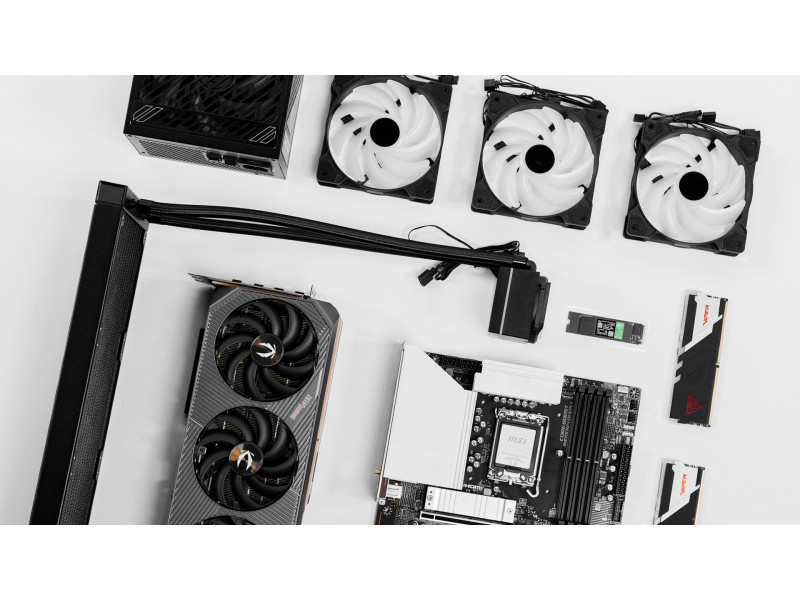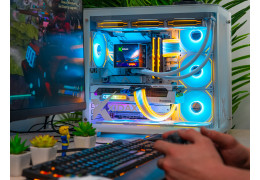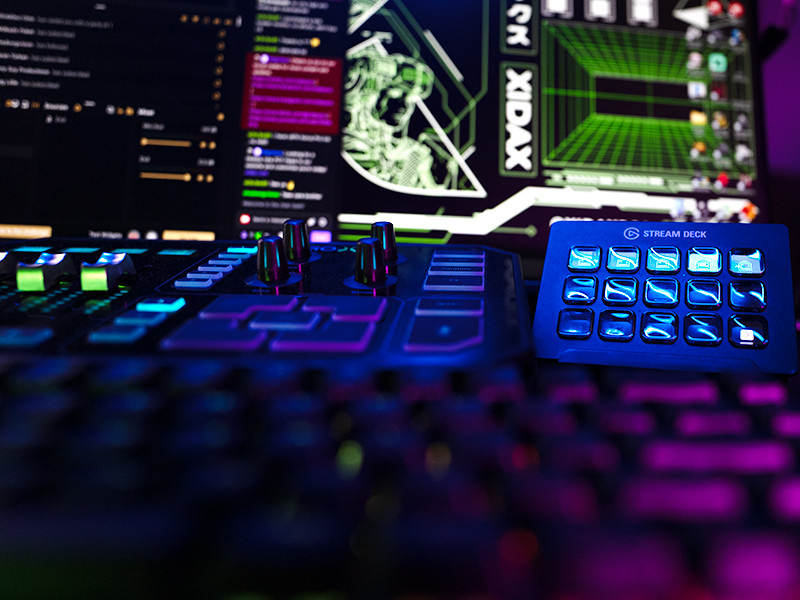How to Choose the Best Graphics Card (GPU) for Your Playstyle in 2025 (FPS vs. MMO vs. 4K Gaming)
Choosing the best graphics card (GPU) for your next gaming PC depends on what games you play and what you want – high frame rates for fast shooters (FPS), detailed worlds for MMOs, or ultra-detailed 4K resolution. This article will break down how to make the best selection for your play style so you can build a custom PC that fits the games you like to play most - and we'll recommend Xidax systems that meet your needs.
If making all these hardware decisions feels too complicated or time-consuming, try our Easy Mode builder instead - we can kick start your build process by recommending builds to you based on the games you play.
Want the Best GPU? Here's Where to Start
To make the best choice for your preferred gaming experience, let's first look at a GPU’s key specs in simple terms.
VRAM
VRAM (video memory) is the GPU’s “scratchpad” for textures and frame buffers – higher VRAM (e.g. 12–16+ GB) lets you use higher resolutions and detailed textures without slowdowns.
CUDA Cores
CUDA cores (NVIDIA) or stream processors (AMD) are the card’s workhorse compute units – more cores generally means higher raw performance. For example, the Geforce RTX 5080 has 10,752 CUDA cores and 16 GB of fast GDDR7 VRAM, while the high-end graphics cards like the NVIDIA RTX 5090 doubles that to 21,760 cores and 32 GB GDDR7. Higher clock speeds also boost performance per core, and the latest generation of graphics cards is packed with power.
Ray Tracing and Tensor/AI Cores
Importantly, modern GPUs include dedicated ray-tracing cores and tensor/AI cores. Ray-tracing cores (4th gen on Nvidia’s RTX 50 series) accelerate realistic lighting effects, though they can lower frame rates when enabled. Tensor (AI) cores power features like Nvidia’s DLSS upscaling.
Nvidia DLSS vs. AMD FSR:
These technologies use smart upscaling to boost frame rates. DLSS (Deep Learning Super Sampling) runs a trained AI model on Nvidia GPUs to render at lower resolution and output a higher-resolution image. AMD’s FSR (FidelityFX Super Resolution) is a similar upscaling toolkit that works on many GPUs (AMD or even older Nvidia cards). Both allow you to crank up visual quality without a massive performance hit. Use DLSS or FSR if you want smoother play on demanding settings.
In summary, higher VRAM lets you play at higher resolutions and settings; more cores and higher clocks give higher frame rates; ray-tracing cores enable advanced lighting but aren’t essential for every game; and DLSS/FSR can multiply your performance by smart upscaling. Now let’s match these traits to common playstyles:
Best Graphics Cards for Fast-Paced Shooters (FPS Gaming)
Competitive shooters (e.g. Valorant, CS:GO, Call of Duty) demand extremely high frame rates (120+ FPS) at 1080p or 1440p. Prioritize raw speed and low latency: a midrange GPU with high clock speeds and enough VRAM (8–12 GB) is ideal. For example:
- Nvidia’s Geforce RTX 4060 Ti or RTX 4070 series can deliver ultra-smooth 1440p gameplay.
- The RTX 5070 (6,144 CUDA cores, 12 GB GDDR7) from the new 50-series is also well suited for high refresh-rate 1440p play.
- Likewise, AMD’s Radeon RX 7600 or 7700 XT (with 16 GB) offer strong 1440p performance at typically lower price.
Xidax’s X-6 Pre-Built Gaming PC with Ryzen 7 7800X3D and RTX 5070 is designed for 1440p/4K performance, delivering blazing-fast responsiveness and smooth visuals. It has 32 GB DDR5 RAM and a 1 TB SSD, and is built in a compact XEN case for easy cooling.
Key point: For pure FPS, you don’t need the absolute top-end card. A GPU with strong raster performance and features like Nvidia Reflex (for lower latency) is better than a huge 4K card. Xidax systems with RTX 4070/5070-class GPUs give excellent value for high refresh-rate gaming.
Best GPUs for MMOs and Open-World Games
MMOs and large open-world games (e.g. World of Warcraft, Final Fantasy XIV, Elden Ring) can be GPU-intensive at 1440p with high settings and many players/objects on-screen. You want good all-around performance plus generous VRAM for large textures (12–16 GB or more).
- A GPU like the RTX 4080 Super (at least 16 GB GDDR7) or the new RTX 5080 (16 GB) is a solid choice.
- The RTX 5080’s 10,752 cores and 16 GB GDDR7 deliver smooth gameplay even in complex scenes.
- AMD’s Radeon RX 7800 XT (3,840 stream processors, 16 GB GDDR6) also excels at 1440p/MOBO gaming.
The Xidax X-6 ONAMI Gaming PC with Ryzen 7 7800X3D and RTX 5080 is built for these scenarios. As Xidax notes, it delivers smooth 1440p and 4K gameplay with its 5080 GPU and 32 GB RAM, all inside a sleek Onami Black case with liquid cooling. This rig can run demanding MMOs at high frame rates while maxing out visuals.
Key point: For MMO/open-world play, aim for high VRAM and strong mid-to-high-end GPUs. Cards like RTX 4080, 5080, or AMD 7800 series give you the needed horsepower and memory. They’ll run games at 1440p or even 4K with good performance and eye candy.
Best GPUs for 4K and High-Resolution Gaming
If your goal is maxed-out 4K gaming or pushing frame rates at ultra-high resolutions, you need the top-tier GPUs.
- Nvidia’s RTX 5090 (21,760 cores, 32 GB GDDR7) sits at the top; it has an enormous compute capability and memory for 4K and next-gen features.
- The RTX 4090/4080 Super (from 40 series) are also excellent at 4K. On the AMD side, the Radeon RX 7900 XT/XTX (6,144 cores, 24 GB GDDR6) are competitive 4K workhorses.
- For pure 4K with ray tracing on, Nvidia’s DLSS or AMD’s FSR upscaling will help maintain smooth frame rates.
For the ultimate 4K rig, check out Xidax’s X-6 ONAMI Gaming PC with RTX 5090 and Intel Core Ultra 9 285K . It delivers cutting-edge performance – specifically peak 4K and ray-tracing performance – thanks to its new 5090 GPU, 64 GB of RAM, and 2 TB NVMe SSD for fast loading. This kind of build is overkill for simple games, but perfect if you want every frame possible at 4K with maxed settings.
Key point: High-resolution gaming demands top-end cards and tons of memory. An RTX 5090 or AMD 7900 XTX gives the best future-proofing. Balance your budget: if 4K is your target, invest in a high-tier GPU; if not, save money with a 40/50-series midrange card and focus on refresh rate instead.
Balancing Value and Performance in your GPU
It’s easy to overspend on an upper-echelon GPU you’ll never fully use. Match the GPU to your monitor and games.
- For 1080p high-FPS play, a midrange GPU offers the best bang for buck. For 1440p/ultrawide or mixed FPS/MMO play, a high-midrange card is ideal. And for 4K or VR, go high-end.
- Also consider technologies: if you play ray-traced games, Nvidia’s RTX cards with DLSS might give better performance (DLSS 4 with Frame Generation can significantly boost FPS).
- AMD’s cards are strong on traditional raster performance and now support FSR upscaling too.
When shopping, check Xidax’s custom PC options. For example, Xidax’s X-6 Xen Black system lets you pick GPUs from the RTX 40 or 50 series or AMD’s RX 7000 series. These come with lifetime warranties and are optimized for gaming performance. You can customize a PC with an RTX 5070 Ti for $2–3K or splurge on a 5090 build at around $6K, depending on parts. We make it easy – just choose the GPU that fits your playstyle and budget.
Conclusion
In summary, align your GPU choice with your primary games and resolution.
- FPS gamers want high clocks and core counts (e.g. RTX 5070 Ti or RX 7700),
- MMO/open-world players need lots of VRAM and solid all-around performance (e.g. RTX 5080 or RX 7800 XT)
- 4K enthusiasts should pick top-tier cards (RTX 5090 or RX 7900 XTX) for that extra headroom. Each generation (RTX 40 and now 50 series, and AMD’s RX 7000 series) has options at every level.
- Always weigh value vs. performance – there are great deals in the midrange that can hit your target frame rates without overkill.
Ready to build? Xidax offers many RTX 50-series builds (and AMD RX 7000 builds) to match your goals. Explore our gaming desktops to find the right configuration (and lifetime warranty) for your gaming playstyle. Happy gaming!


